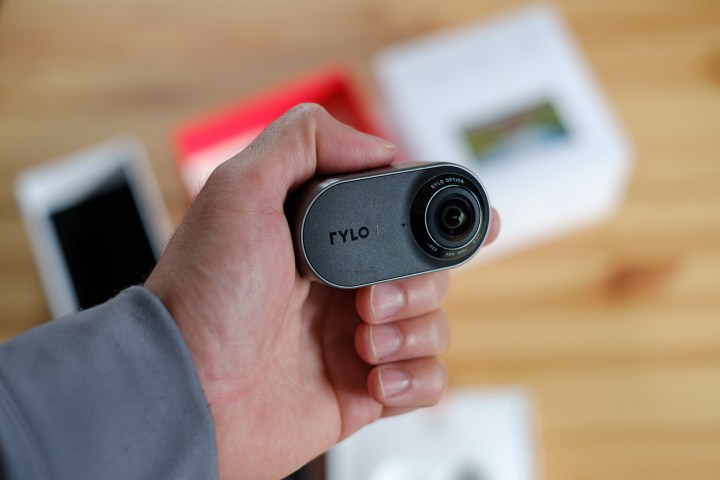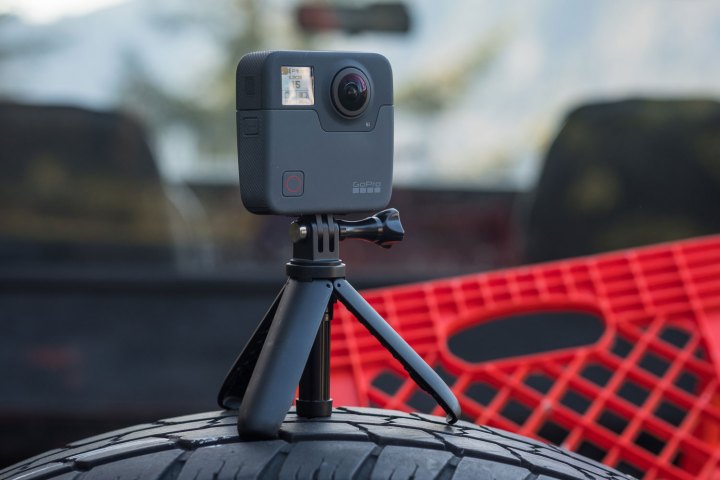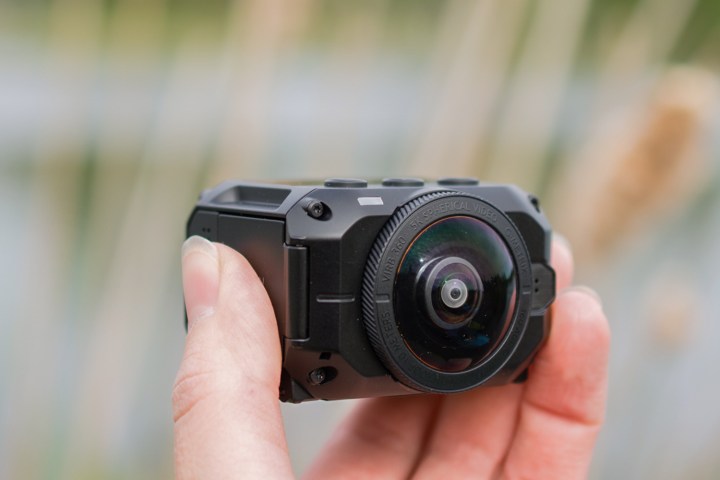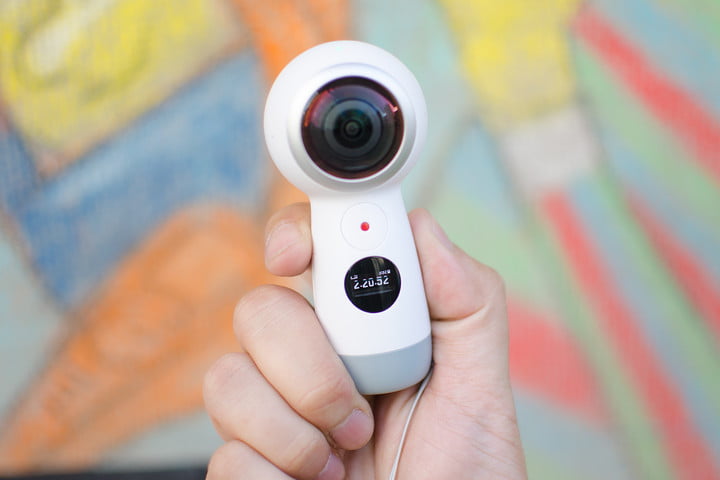
360 cameras haven’t had the revolutionary success story their makers were hoping for, but there are a few models that stand out and continue to push the format format. Our pick for the best 360 cam is the Rylo, a compact, dual-lens model that uses 360 not for sharing immersive content, but for creating better fixed-frame video (that is, traditional “flat” video). It comes with an easy to use app that lets you reframe content on the fly and share it to social media as quickly as possible. In fact, of the hundreds of cameras we’ve reviewed — 360 or otherwise — the Rylo has the best mobile editing app of them all.
360 may have started as a gimmick, but cameras like the Rylo are showing that there is a real consumer application for it. There are other 360 cams worth considering, though. The GoPro Fusion produces extremely clean stitching if you have the patience for it, and the slim Ricoh Theta will easily fit in just about any pocket. Here are the best 360 cameras you can buy right now.
At a glance
| Product | Category | Rating |
| Rylo | The best | 3.5 out of 5 stars |
| GoPro Fusion | The best high-end 360 camera | 3.5 out of 5 stars |
| Garmin Virb 360 | The best heavy-duty 360 camera | 4 out of 5 stars |
| Samsung Gear 360 (2017) | The best 360 camera for live-streaming | 3.5 out of 5 stars |
| Ricoh Theta V | The best 360 cam for travel | 3.5 out of 5 stars |
The best: Rylo

Why should you buy this? Reframe 360 video in post for smooth and fun fixed-frame output.
Who’s it for? Just about anyone.
Why we picked the Rylo:
While most 360 cameras are about letting viewers change perspective by panning and tilting during playback, the Rylo takes a different approach. It still records a spherical area like any other 360 cam, but it puts tools in the creator’s hands to reframe that content for traditional fixed-frame output. Using a revolutionary method of keyframes, you can set points to look to and the software will magically change perspective, smoothly transitioning from one point the next. You can also smoothly zoom in or out, or even speed the footage up into time-lapse mode.
Rather than set points manually, you can also tap on an object and the software will track it automatically, keeping it in the frame whether it moves behind, below, or above the camera.
This is all done from an expertly made mobile app that’s simply one of the best companion apps we’ve ever seen. When you share the final output, your viewers are treated to a polished fixed-frame video with professional looking camera moves that’s easily digestible on social media.
The camera also features some of the best image stabilization out there (a feature common on 360 cameras), and serves up a host of other options like picture-in-picture display of two angles simultaneously and a little planet mode. And, yes, you can still output the full 360-degree frame if you want to share an immersive video. With the optional protective case, the Rylo becomes a great action camera, as well — record everything around you, then go back and find the most interesting angles later.
Our full Rylo review
The best high-end 360 camera: GoPro Fusion

Why should you buy this? Durable and powerful, the Fusion is the 360 cam of choice for professionals.
Who’s it for? Pros after the best sticking quality who don’t mind putting in long hours at the desktop to get it.
Why we picked the GoPro Fusion:
Considering the success of its action cameras, it shouldn’t come as a surprise that GoPro has one of the most complete 360 cameras on the market.
Looking at the outside, it’s clear GoPro took inspiration from its lineup of Hero action cams. The Fusion features a two-tone ruggedized design that’s waterproof down to 16 feet.
Like other 360 cameras, the GoPro Fusion features two cameras — one on either side of its cuboid shape — and captures 5.2K footage at 30fps. Unlike other dual-lens 360 cams, GoPro has opted to offset the two cameras on the device, a decision that’s said to minimize stitching artifacts. Interestingly, GoPro has also incorporated dual card slots, with each camera recording to a separate memory card. While not necessarily a negative due to GoPro’s seamless merging of files when offloaded from the camera, it does mean you’ll need to remember to insert and format two memory cards.
One of the most compelling features of the GoPro Fusion is what GoPro calls OverCapture. Built into the accompanying GoPro Fusion smartphone app, OverCapture is a tool that lets you pull out traditional 16:9 fixed-frame video from the 360-degree footage. The experience, however, is not as intuitive as the Rylo’s.
But if quality 360 output is what you need, the Fusion produces the cleanest stitching of any two-lens 360 camera we’ve seen. Unfortunately, you need to stitch the files using GoPro’s desktop app to achieve these results, and it can take a very long time. Stitching in the mobile is much faster, but the results are far inferior.
The GoPro Fusion also includes a GPS, compass, accelerometer, 3D audio, and a gyroscope, making it one of the most feature-packed options on the market. It’s also come down in price since it’s initial launch at $700.
Our full GoPro Fusion review
The best heavy-duty 360 camera: Garmin Virb 360

Why should you buy this? Easy-to-use, durable 360 action camera that’s both full of features and low on those annoying stitch lines.
Who’s it for? Action junkies who want a 360 camera that can follow the action pretty much anywhere.
Why we picked the Garmin Virb 360:
Most 360 cameras we’ve tried are either lacking in usability or image quality, but the Garmin Virb 360 hits both marks and then tosses in some pretty sweet data overlays for action videos. While you’ll still notice some stitching lines on objects close to the camera (like whatever the camera is mounted to), the Virb 360 had the most seamless stitches we’ve seen yet. That’s thanks in part to two different stitching modes for near and far – so you will have to remember to switch modes when heading from the big outdoors to the inside of a small room. Resolution and detail is comparable with other 4K 360 cameras, but that nearly seamless stitching puts the Virb 360’s image and video quality a bit above the rest.
The Virb 360 is also easy to use, largely because Garmin made room for a small display. The companion smartphone app is still the best way to use the camera, but if you need to leave your smartphone on shore, you can use the camera’s controls to start and stop a video or take a picture — a nice feature considering the camera is rated to head down to 32 feet underwater.
In addition, Garmin added features that are just now coming into the action camera category, including voice controls. The Virb 360 includes image stabilization, with multiple steady modes that make a big difference in the final video. The Virb 360 includes a number of different built-in sensors, much like the Virb Ultra 30 action camera, that allows users to add overlays that share details like how fast you were going or even how high you jumped. Both the stabilization options and overlays are accessible in both the Garmin app and the desktop editor.
Between the almost stitch-free videos, easy use, rugged design, and extras like stabilization and action overlays, the Garmin Virb 360 is a serious performer. Live video is also supported, but it only works with iOS devices. At $799, the Virb 360 is overkill for users who don’t need the “action” features, but if you absolutely need the ruggedness and feature set, it’s a solid choice.
Our full Garmin Virb 360 review
The best 360 camera for live-streaming: Samsung Gear 360 (2017)

Why should you buy this? Easy live-streaming in 360, and it won’t break the bank
Who’s it for? Any consumer that wants to get started in 360 without paying big price tag
Why we picked the Samsung Gear 360:
The Garmin Virb 360 is a great action camera, but $799 is probably overkill for simple 360 shots. The Samsung Gear 360 is an easy-to-use camera from the company that spearheaded the 360 movement and it offers excellent connectivity and simple live-streaming. But the best part? While Samsung still lists the Gear 360 as $229, it can be found online for under $100 — brand new.
The Gear 360 packs two lenses into a spherical body with a permanently attached stand that doubles as a handle. While the 2017 update maintains a similar design principle as the original model, it’s smaller, weighs 4.6 ounces, and is easier to hold. While it’s not designed to take a dip, it can withstand some dust and scratches.
A companion smartphone app pairs with the the Gear 360 seamlessly — a great improvement over the first version. The app is also more responsive, and is now compatible with select iPhones and Samsung Galaxy devices.
The Samsung Gear 360 also brings 4K resolution. The image quality isn’t the best, but it’s pretty decent considering the price point. Live streaming, however, isn’t available in 4K, but you can stream Full HD to both Facebook and YouTube.
Our full Samsung Gear 360 review
The best 360 cam for travel: Ricoh Theta V

Why should you buy this? It’s a simple, capable camera that works alongside Ricoh software to capture and share 360 content with minimal hassle at a reasonable price.
Who’s it for? Anyone who wants a simple, compact solution to capturing 360 content
Why we picked the Ricoh Theta V:
When it comes to the best balance between cost, looks, and performance, you’ll be hard-pressed to find a better option than the Ricoh Theta V. It’s down the middle on the price spectrum and has a feature set and spec sheet that punches slightly above its weight class. But the best part is that its slim design allows it to be slipped into virtually any pocket, making it a great option to carry with you while traveling.
The Ricoh Theta V captures 14-megapixel stills and 4K video through its two lenses — one on either side of the remote-shaped device. Unlike other 360 cameras we’ve tested, the Theta V rarely, if ever, has noticeable stitch artifacts, aside from a little fringing and exposure difference where the two hemispheres merge together. Video quality, like most 360 cameras, is so-so, but still image quality is actually quite nice.
One of the biggest drawbacks of the Theta V is that there’s no option for external storage via MicroSD cards, meaning all images are stored directly onto the device’s internal memory, which is capped at a measly 19GB. You’ll need to offload it to your mobile device more often than some other 360 cams in order to keep that memory clear.
The accompanying app from Ricoh is one of the more thought-out companion apps and makes it easy to offload footage onto your mobile device so you have more room to shoot. There’s also a separate Theta+ app available that lets you edit your images on-the-fly before posting them to social media.
Our full Ricoh Theta V review
Before you buy
If you buy an $800 360 camera and expect to see the same quality as an $800 DSLR, you’re going to be disappointed. Current specs employed by consumer 360 cameras can’t muster the kind of image quality you’d find in a traditional camera, considering it’s shooting and processing more information. Heck, your smartphone photos will look better. But for now, the point of this niche camera is to capture nearly everything around you, which you can then play back or share as an immersive experience.
Luckily, prices for some new 360 cameras have come down, like Samsung’s Gear 360. So, before you jump into the 360 bandwagon, there are two things you need to know.
4K in 360 isn’t the same as regular 4K. In 360, all those pixels are wrapping all the way around a spherical field of view. That means you don’t get the same level of detail for any one perspective. Some 360 cams now push beyond 4K into 5K territory, but in our experience, detail for any given frame still drops below what you would see with even with a standard camera at Full HD 1080p.
Most 360 footage comes from multiple cameras. A 360 camera is really two (or more) cameras in one. Software (either in-camera or on a computer) stitches the two hemispheres together. Expect to see some sort of stitching artifact or edge in the video, but newer cameras are getting better and better at a creating seamless picture. The GoPro Fusion is particularly adept at this, but only when using GoPro’s desktop software — stitching in the mobile app yields much worse results.



